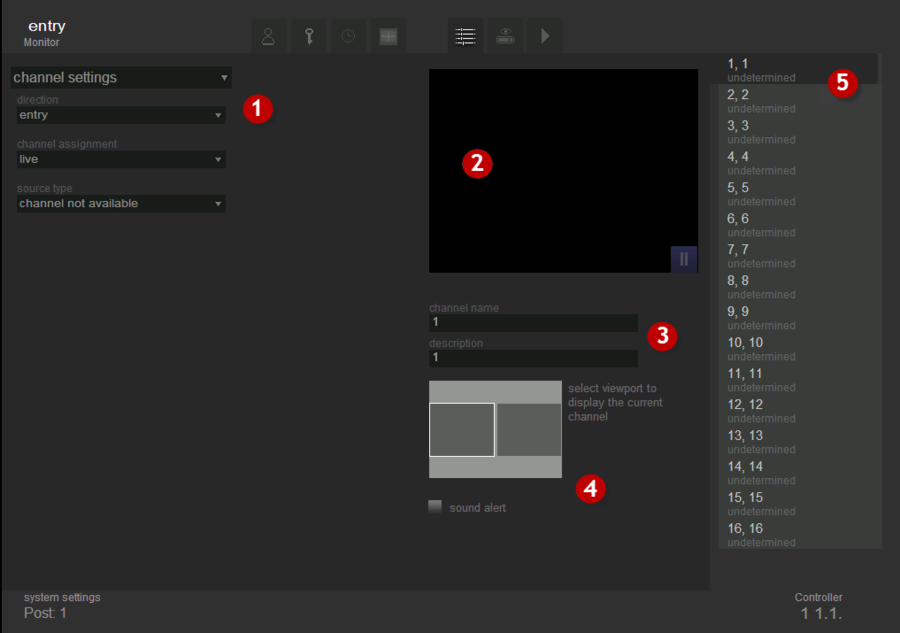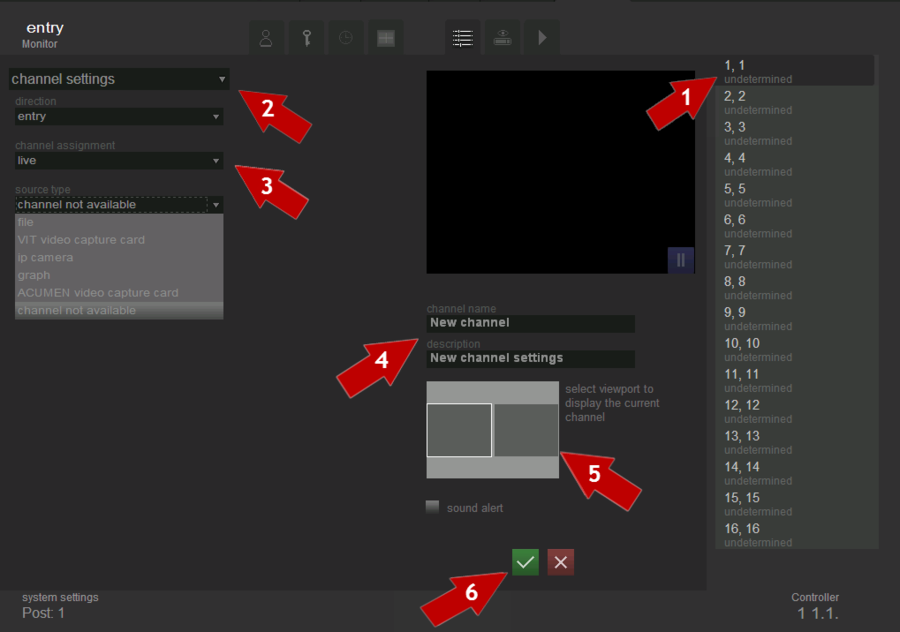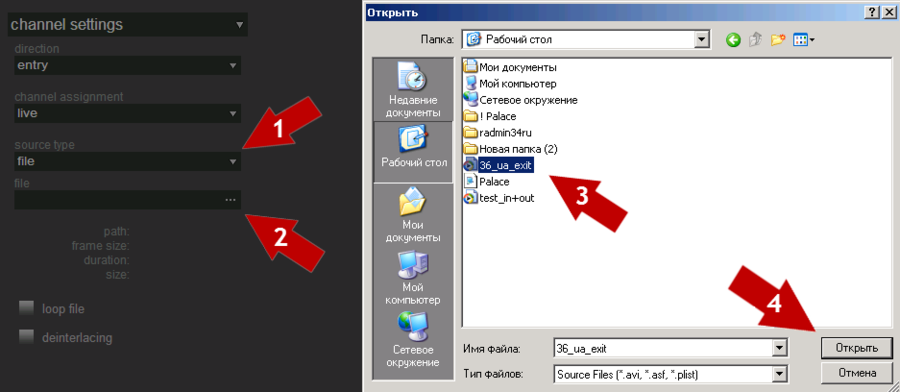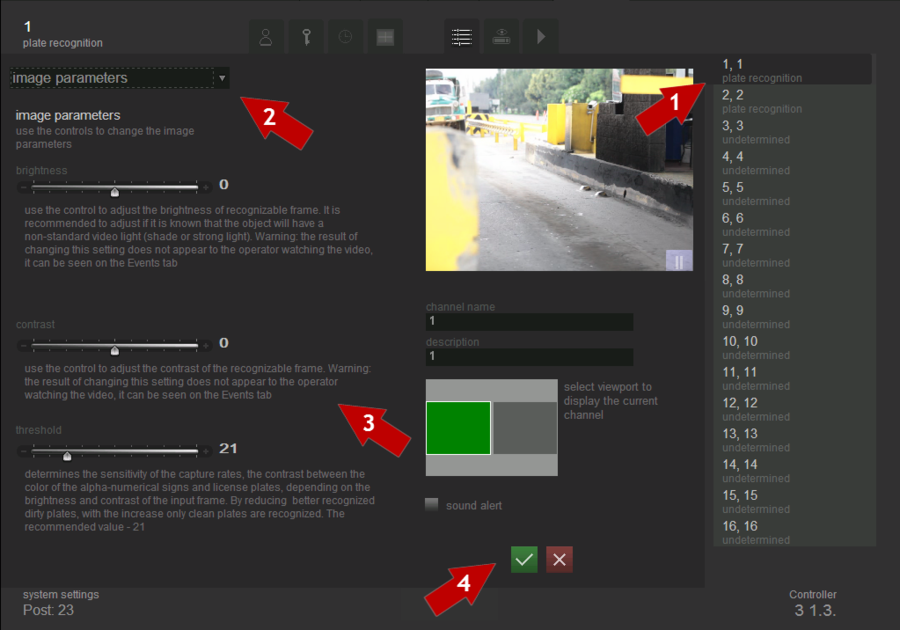Channel configuration in AutoCode XProtect 1.0 Traffic
Connection of video sources
This tab is used for connection of video sources and display options. The exterior view of the tab is shown in fig. Channel settings. “Settings” tab.
The tab consists of 5 parts:
- type of configuration ( Channel settings or Image Parameters) and its parameters;
- viewport - to display video from the selected source;
- fields for editing the name and description of the selected channel;
- position to determine the viewport for displaying the selected channel in monitoring mode;
- channel list.
Channel settings
To configure the channel it is needed to do the following actions in order to configure the channel (see fig. Channel settings.Settings sequence):
- select a channel from the channel list, that you want to configure;
- select the type of configuration- “channel settings”;
- set channel parameters;
- set its name and description(if necessary);
- select the viewport in which the video of the current channel will be displayed on the “Live” tab;
- click the “Save”
 button.
button.
Channels list
List of channels, their names, designation and description - clicking on an entry in this list determines which channel is configured at the moment. Settings for each channel are unique and do not depend on the configuration of other channels, except for resolution settings and color space for video capture card, which must be the same for each channel on a particular processor board.
Channel parameters settings
While configuring channels parameters it’s necessary to indicate the channel purpose and the type of source for receiving the data.
Channel purpose
Channel purpose – is a setting which is needed to determine the operation mode of the channel.
- live - the mode in which the recognition of number plates is not made;
- demo - the mode in which the recognition of number plates is made, all possible alerts are displayed to the operator;
- flow (path) – the mode in which the recognition of number plates are made, though, only alarm alerts are shown to the operator.
Source type
Source type - is a setting which determines how the video flow and the parameters of its transmission are transferred to the system.
File
This source type is used when it is necessary to recognize license plates from existing on the computer video files (such as recorded video archive).
In order to select and configure the file as a data source it is necessary to perform the following steps consistently (see fig. Channel settings. Selecting video file):
- select source type – file;
- click the
 button “file” in the filed file;
button “file” in the filed file; - select the file that must be opened;
- click the button “Open”;
- configure the video flow transmission parameters.
It is possible to play not only single files, but play-lists. To set play-list as a video source after click on a button ![]() «File» it is nesessary to choose not single file, but play-list, that was cheated before.
«File» it is nesessary to choose not single file, but play-list, that was cheated before.
When the file or play list is selected, it is possible to specify looping and de-interlacing options.
The selection of the option “loop file” leads to the fact that after the end of the selected file it starts to play again. If this option is not selected, then after the end of the file it stops to play. In order to loop the file, it is necessary to put the flag next to the option “loop file”.
The selection of the option "deinterlace" applies the filter required to eliminate the effect of interlacing to the selected video. In the case of interlacing, which arises when combining the previous half-frame with the current one (e.g. the even lines- from the current half-frame and odd- from the previous one) in the video of interlaced format, the edges of lenses have the form of comb (see fig. Frame with interlacing) which significantly affects the recognition quality.
To get rid of this unpleasant effect and to improve the recognition quality one must select the option “deinterlacing”.
Milestone
In order to select and configure the video from Milestone systems as a video source it is necessary to perform the following steps consistently (see fig. Channel settings. Selection and adjustment Milestone as a video source):
- select source type – IP-camera ;
- select type of the camera - Milestone;
- configure the video flow transmission parameters.
IP address. Enter the IP-address of the Milestone video server into this field in format ххх.ххх.ххх.ххх:хххх. Enter the IP-address of the camera before “:” and after this symbol enter the number of the port.
Login and password. In these fields login and password should be entered for access to the Milestone video server.
Authorization. This field is for choosing the type of authorization on the Milestone management server. Basic, Windows and Current user (Windows) types of authorization are being supported, in dependence of the type of XProtect software.
Camera. This field is used to select a particular camera, video of which will be displayed in the viewport.
The Button ![]() is used to create the list of available cameras. When clicking, a list of available cameras appears in the drop-down box ”Camera”.
is used to create the list of available cameras. When clicking, a list of available cameras appears in the drop-down box ”Camera”.
JPEG. Activation of this setting make system request video stream in JPEG format. In this case, transmission will be done in lower speed, though image quality may be higher, because in JPEG format each frame is transmitted independently from the adjacent frames.
Deinterlacing. Activates deinterlacing filter.
Event Server. Address of the server for Analytics event sending to Milestone. Enter the IP-address of the event server into this field in format ххх.ххх.ххх.ххх:хххх. Enter the IP-address of the server before “:” and after this symbol enter the number of the port.
Protocol. This field specifies the protocol for sending data to analyst - TCP or UPD. The chosen value must correspond value in the Management Application.
Event Server (genetic). Address of the server for generic event sending to Milestone. Enter the IP-address of the generic event server into this field in format ххх.ххх.ххх.ххх:хххх. Enter the IP-address of the server before “:” and after this symbol enter the number of the port.
Attention!
Generic event it’s a trigger, another events can be related with it. Analytics event returns data to Smart Client (including data about plate number, event type, ect.).
Protocol (genetic). This field specifies the protocol for sending data to analyst - TCP or UPD. The chosen value must correspond value in the Management Application.
Select number. Highlights number with a frame when viewed in Smart Client.
Time correction. In some cases incorrect selection of number is possible. This setting ensures it’s correct displaying. Recommended value – 50 msec.
Channel name and description
The channel name and its description are intended to facilitate the work of operators. For example, specifying the location of the camera in future could greatly accelerate processing of information by the operator; since he will not have to guess from which camera the image was received.
Viewport’s selection
When choosing the viewport for display on the "Live" tab one should pay attention to the following notation:
- gray viewport - free, can be selected to display the video flow;
- green viewport - selected at the moment to display the video flow;
- red viewport - is in use by another channel, can not be selected to display the video flow.
If the setting is done correctly, then the following changes will occur on the tab “Channel Settings” (fig. Channel settings. Configured channel):
- the name of the channel, the motion direction and its purpose (in case it is specified) will appear in the upper right corner;
- video flow from selected source will appear in viewport for displaying video;
- channel description and its assignment will appear in the channel list.
Image parameters settings
A description of the channel and its purpose will appear in the channel list. In order to configure the image, one must perform the following steps (see fig. Channel settings. Setting image parameters):
- select a channel form the channel list, which you want to configure;
- select the type of setting- “ Image Settings”;
- set image settings;
- click the button
 “ Save”.
“ Save”.
Brightness
This setting provides software brightness control of the frame that is being recognized. It is recommended to adjust this setting if you know that the object of observation will have a non-standard lighting (shaded or highlighted).
Attention!
Changes of this setting are not visible for an operator; they can be tracked back by frames in the "Events" tab.
Contrast
This setting provides software contrast control of the frame that is being recognized.
Attention!
Changes of this setting are not visible for an operator; they can be tracked back by frames in the "Events" tab
Threshold
This setting determines capturing sensitivity. Contrast between the color of alphanumeric signs and license plates depends on the brightness and contrast of the incoming frame. Reducing this setting enables better recognition of dirty plates; increasing this setting allows recognition of clean plates only. Recommended value — 21.
Channel configuration in AutoCode XProtect 1.0 Traffic Настройка канала в системе AutoCode XProtect 1.0 Traffic Configuración de canal en AutoCode XProtect 1.0 Traffic





